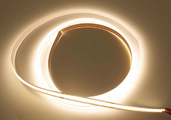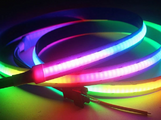How Do Neon Strip Lights Differ from LED Strip Lights?
Understanding the Differences: Neon Strip Lights vs. LED Strip Lights
When deciding between neon strip lights
and LED strip lights for your lighting projects, it’s crucial to understand the key distinctions that set them apart. This detailed comparison will guide you through their differences, helping you make an informed choice based on efficiency, lifespan, aesthetics, and cost.
Brightness and Color Rendering
Neon lights are known for their vibrant, uniform illumination. They emit light using gas discharge, primarily neon gas, which ensures a consistent glow along their length. Neon strip lights produce a brightness ranging typically from 500 to 1,000 lumens per meter. LED strip lights, on the other hand, use light-emitting diodes and have a broader range in brightness, from 300 to 2,000 lumens per meter, depending on the quality and type of LED used.
In terms of color rendering, LED strip lights generally have a higher Color Rendering Index (CRI) – usually above 80, with premium models reaching up to 95. This means they are better at showing the true colors of objects. Neon lights typically have a lower CRI but offer richer and deeper hues, making them a favorite for mood lighting and artistic installations.
Energy Efficiency and Lifespan
LED strip lights excel in energy efficiency. They consume less power, about 4-10 watts per meter, compared to 20-30 watts per meter for traditional neon lights. This makes LEDs a more cost-effective choice in the long run. Additionally, LED lights have a longer lifespan, generally lasting up to 50,000 hours, whereas neon lights typically max out around 30,000 hours.

Flexibility and Installation
Neon strip lights offer a seamless glow that can be seen from all angles and can be bent into various shapes without affecting their brightness. This makes them ideal for complex designs and curves. However, they are generally more fragile and harder to install due to the delicate nature of the glass tubes used.
LED strip lights are highly versatile and can be cut to specific lengths to fit different spaces. They are easier to install, with adhesive backings and simple plug-and-play connectors. However, they do not bend in multiple directions like neon strips, which can limit their use in rounded or irregularly shaped designs.
Cost Comparison
Initial costs for neon strip lights tend to be higher due to the materials (glass tubes, gas) and the labor-intensive manufacturing process. However, their unique aesthetic often justifies the higher price tag for designers looking for a distinctive style. LED strip lights are generally more affordable and accessible, suitable for both residential and commercial use.
Safety and Durability
Neon lights operate at a higher voltage, usually between 3,000 to 15,000 volts, which can pose a greater risk if not properly installed. They are also more susceptible to damage if the glass tubing breaks. LED strip lights operate at a much safer 12 to 24 volts and are enclosed in durable resin, making them resistant to breakage and safer for home and commercial environments.
When you’re looking to choose the right type of lighting for your project, consider the unique glow and artistic flexibility offered by neon strip lights. Their charm and distinct appearance provide a classic yet vibrant look, ideal for adding character to any space.
In choosing between neon strip lights and LED strip lights, consider not just the cost and installation but also the intended use and desired aesthetic. Each type has its place in design, and understanding these nuances will help you make the best decision for your specific needs.





